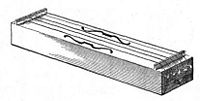Aeolian harp

An aeolian harp (or æolian harp or wind harp) is a musical instrument that is "played" by the wind. It is named for Aeolus, the ancient Greek god of the wind.
History
Aeolian harps were very popular as household instruments during the Romantic Era, and are still hand-crafted today. Some are now made in the form of monumental metal sound sculptures located on the roof of a building or a windy hilltop.
Description
The traditional aeolian harp is essentially a wooden box including a sounding board, with strings stretched lengthwise across two bridges. It is placed in a slightly opened window where the wind can blow across the strings to produce sounds. The strings can be made of different materials (or thicknesses) and all be tuned to the same note, or identical strings can be tuned to different notes.
Sound
The sound is random, depending on the strength of the wind passing over the strings, and can range from a barely audible hum to a loud scream. If the strings are tuned to different notes, sometimes only one tone is heard and sometimes chords.
Operation
The harp is driven by an aeroelastic effect. The merest motion of the wind across a string forces the air on the leading side to move faster than that on the trailing side; then (see Bernoulli's principle) the pressure ahead is slightly less than that behind, pushing the string further to the side, until the restoring force arising from deflection halts and reverses the motion.
The effect can sometimes be observed in overhead utility lines, fast enough to be heard or slow enough to be seen. A stiff rod will perform; a non-telescoping automobile radio antenna can be a dramatic exhibitor. And of course the effect can happen in other media; in the anchor line of a ship in a river, for example.
Aeolian harps in literature and music
Henry Cowell's Aeolian Harp (1923) was one of the first piano pieces ever to feature extended techniques on the piano which included plucking and sweeping the pianist's hands directly across the strings of the piano. The Etude in A flat major for piano (1836) by Frédéric Chopin (Op. 25, no. 1) is sometimes called the "Aeolian Harp" etude, a nickname given it by Robert Schumann. The piece features a delicate, tender, and flowing melody in the fifth finger of the pianist's right hand, over a background of rapid pedaled arpeggios. One of Sergei Lyapunov's 12 études d'exécution transcendante, Op.11 No.9, is named by the author "Harpes éoliennes" (aeolian harps). In this virtuoso piece, written between 1897 and 1905, the tremolo accompaniment seems to imitate the sounding of the instrument.
In 1972, Chuck Hancock and Harry Bee recorded a giant Aeolian harp reportedly built by the members of a commune on a hilltop in California. United released their double LP entitled The Wind Harp - Song From The Hill. In the spirit of this, in 2003 an Aeolian harp was constructed at Burning Man. Australian artist, composer and sound sculptor Alan Lamb has created and recorded several very large scale aeolian harps.
ReferencesISBN links support NWE through referral fees
- Bonner, Stephen, Aeolian harp, Cambridge: Bois de Boulogne, 1968. ISBN 0-900-99800-8
- Hankins, Thomas L.; Silverman, Robert J., Instruments and the imagination, Princeton, NJ: Princeton University Press, 1995. ISBN 0-691-02997-0
- Mansfield, Jonathan, The design and construction of an Aeolian harp, Cambridge: Bois de Boulogne, 1970. ISBN 0-900-99810-5
Credits
New World Encyclopedia writers and editors rewrote and completed the Wikipedia article in accordance with New World Encyclopedia standards. This article abides by terms of the Creative Commons CC-by-sa 3.0 License (CC-by-sa), which may be used and disseminated with proper attribution. Credit is due under the terms of this license that can reference both the New World Encyclopedia contributors and the selfless volunteer contributors of the Wikimedia Foundation. To cite this article click here for a list of acceptable citing formats.The history of earlier contributions by wikipedians is accessible to researchers here:
The history of this article since it was imported to New World Encyclopedia:
Note: Some restrictions may apply to use of individual images which are separately licensed.
